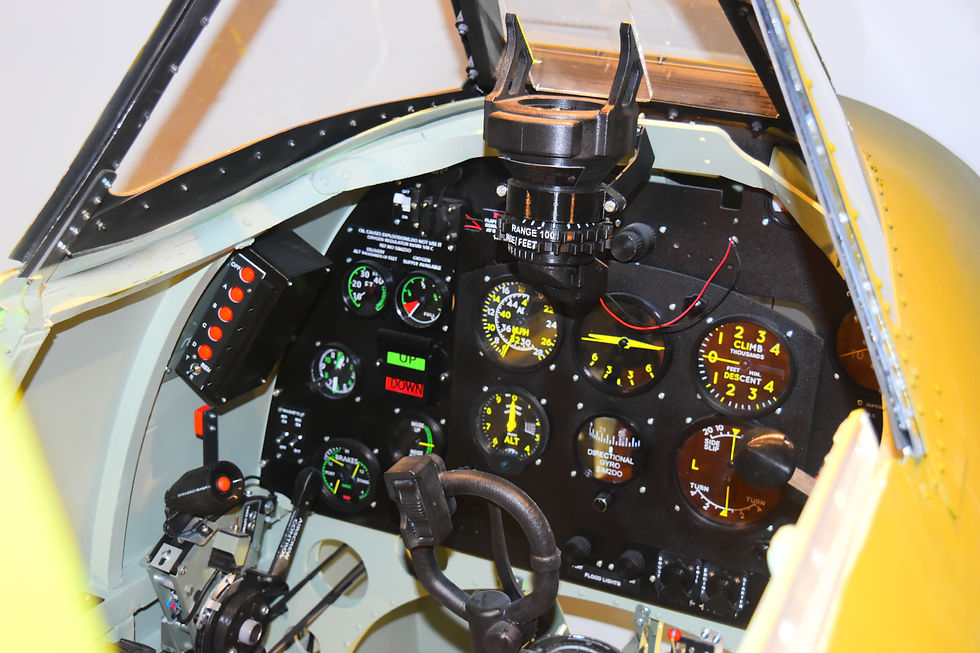Unveiling the Spitfire Mk IX Cockpit
- Kenneth Mockford

- Aug 18
- 4 min read
The Spitfire Mk IX is one of the most iconic fighter aircraft of World War II. Its design improvements over earlier models made it a formidable opponent in the skies. While many enthusiasts admire its sleek exterior and powerful engine, the cockpit is where the pilot truly connected with this legendary machine. Today, I want to take you on a detailed journey inside the Spitfire Mk IX cockpit, sharing insights and practical information about its layout, instruments, and controls.
Understanding the Spitfire Mk IX Details
The Spitfire Mk IX was introduced to address the performance gap against newer German fighters. It featured a more powerful Merlin 61 engine and several design tweaks. But what really interests me is how these changes translated inside the cockpit.
The cockpit was designed with pilot efficiency and combat readiness in mind. Every dial, switch, and lever had a purpose. The layout was compact but functional, allowing pilots to access critical controls quickly during intense dogfights.
Some key features of the cockpit include:
Instrument panel: Centralised and easy to read, with essential flight instruments like the altimeter, airspeed indicator, and artificial horizon.
Throttle quadrant: Positioned on the left side, allowing smooth engine power adjustments.
Control stick: Equipped with a trigger for the machine guns and a button for radio communication.
Rudder pedals: Adjustable to fit pilots of different heights.
The cockpit was not spacious, but it was ergonomically designed to reduce pilot fatigue during long missions.

Key Instruments and Controls in the Spitfire Mk IX Details
One of the most fascinating aspects of the Spitfire Mk IX cockpit is the instrument panel. It was designed to provide all necessary information at a glance. Let’s break down some of the critical instruments and controls:
Airspeed Indicator - Displays the aircraft’s speed in miles per hour. It was crucial for maintaining optimal flying speed during combat and landing.
Artificial Horizon - Helps the pilot maintain level flight, especially in poor visibility.
Altimeter - Shows the aircraft’s altitude above sea level.
Turn and Slip Indicator - Assists in coordinated turns.
Fuel Gauges - Monitors fuel levels to avoid running out mid-flight.
Engine Instruments - Includes oil pressure, temperature gauges, and RPM indicators to keep the engine running smoothly.
The throttle and mixture controls were located on the left side, allowing the pilot to adjust engine power and fuel-air mixture efficiently. The control stick had a trigger for firing the eight .303 Browning machine guns and a button for radio communication.
Pilots had to be familiar with every instrument and control to operate the Spitfire Mk IX effectively. Training focused heavily on cockpit management to ensure quick reactions during combat.

The Pilot’s Perspective: Visibility and Ergonomics
Visibility was a critical factor in the Spitfire Mk IX cockpit design. The canopy was a bubble type, providing excellent all-around views. This was a significant improvement over earlier models with framed canopies that restricted vision.
From the pilot’s seat, you could see clearly in all directions, which was vital for spotting enemy aircraft and navigating through clouds or terrain. The cockpit’s ergonomics also ensured that controls were within easy reach without excessive movement.
The seat was adjustable, and the cockpit was lined with padding to reduce vibration and increase comfort. However, space was tight, and pilots had to be agile to operate the controls efficiently.
The cockpit also featured a gunsight mounted on the windscreen, allowing pilots to aim their weapons accurately while keeping their eyes on the target.

Exploring the Spitfire Mk IX Cockpit
If you want to explore the spitfire mk ix cockpit in more detail, there are excellent resources and simulations available online. These tools allow you to interact with the cockpit layout, understand the function of each instrument, and even practice flying the aircraft virtually.
For enthusiasts and historians, this is a valuable way to appreciate the complexity and ingenuity of the Spitfire Mk IX. It also helps aspiring pilots and model builders gain a deeper understanding of the aircraft’s operation.
I recommend starting with a virtual cockpit tour to familiarise yourself with the controls. Then, try a flight simulation to experience how the cockpit layout supports real-time decision-making and flying.
Why the Spitfire Mk IX Cockpit Still Matters Today
The Spitfire Mk IX cockpit is more than just a collection of instruments and controls. It represents a milestone in aviation design and pilot interface. The lessons learned from this cockpit influenced future aircraft designs, focusing on pilot comfort, visibility, and control accessibility.
For modern pilots and aviation enthusiasts, studying the Spitfire Mk IX cockpit offers practical insights into how aircraft design balances technology and human factors. It also reminds us of the skill and bravery required to fly these machines in combat.
Whether you are a pilot, historian, or simply curious about aviation, understanding the Spitfire Mk IX cockpit enriches your appreciation of this legendary aircraft.
Exploring the Spitfire Mk IX cockpit reveals the thoughtful design and engineering that made this fighter a success. Its compact, efficient layout, combined with excellent visibility and reliable instruments, created a cockpit that was both functional and pilot-friendly. I hope this detailed look has given you a clearer picture of what it was like to sit in the pilot’s seat of one of history’s most famous aircraft.





Comments